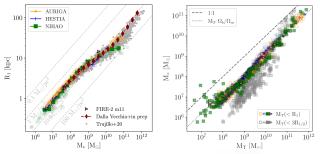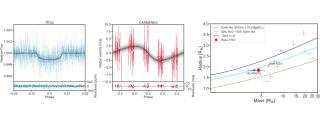Composite image of the Orion Nebula in the [NII], Ha and [OIII] emission lines, codified respectively in red, green and blue. The details in black and white, to the side, illustrate the fields of motion divided into two zones of the nebula during the extr
Advertised on
References
Proceedings IAU Symposium No. 237, 2006
Using images from the HST archive of the Ha and [OIII] l5007A emission lines that are 6.84 years apart, variability in the temperature and density of ionized gas has been detected in intervals of one hundredth of a pc. The temperature variations are in the order of tens of degrees centigrade. Possible mechanisms for explaining this variability have been put forward, including the reconnection of magnetic fields induced by supersonic turbulence in the HII region. At the same time, it has been possible to detect and map the field of motion of gas driven by young or forming stellar winds (Herbig-Haro objects) inside the nebula (L. Gutiérrez, J.E. Beckman, C. Giammanco.)
More info
HST emission line images of the Orion HII region: proper motions and possible variability
Using HST emission line images of the Orion Nebula, separated by 7 years in epoch, we have obtained evidence of localized temporal variability of both density and temperature during this period. Applying a digital filter to reduce high frequency noise, we used images in Hα and [OIII] to quantify separately the variability in these two parameters. We detected fractional temperature variations of order 0.4% on scales of 2x10−2 pc. The same images yielded proper motion information; using cross-correlation to optimize the accuracy of the differential measurements we produced velocity field maps across the nebula, with vectors ranging up to ∼130 km s−1 across the line of sight. It is notable that in zones of rapid proper motion we find by far the largest density variations, as would be expected. It is much easier to quantify the temperature variations, on the other hand, in zones with low or zero detectable proper motion (see the other figure here), though these temperature variations appear across the whole face of the nebula.
Year
2007
![Composite image of the Orion Nebula in the [NII], Ha and [OIII] emission lines, codified respectively in red, green and blue. The details in black and white, to the side, illustrate the fields of motion divided into two zones of the nebula during the extr Composite image of the Orion Nebula in the [NII], Ha and [OIII] emission lines, codified respectively in red, green and blue. The details in black and white, to the side, illustrate the fields of motion divided into two zones of the nebula during the extr](/sites/default/files/styles/crop_rectangle_21x9_to_1280/public/images/news/resultados2_2.jpg?itok=_gB2K7Vp)


